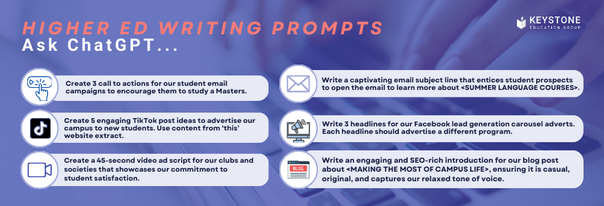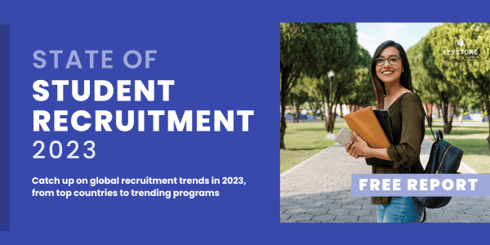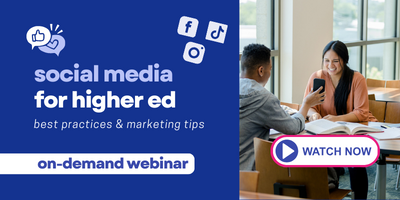- SERVICES
- HIGHER EDUCATION MARKETING
- ENGAGEMENT & ENROLLMENT MANAGEMENT
- STUDENT RECRUITMENT AGENCIES
- PROFESSIONAL EDUCATION & TRAINING
- WHO WE ARE
WHO WE ARE
Learn more about Keystone Education Group, including our leadership structure, why choose Keystone as your educational partner, and company press releases.
QUICK LINKS
- RESOURCES
RESOURCES
Find a range of helpful resources to help with your educational marketing. From on-demand webinars, reports & data, to customer testimonials and our downloadable media kit.
QUICK LINKS
- NEWS
- REQUEST A CALL

- Keystone Higher Education News
- Avoiding Burnout as a Higher Ed Marketer
Working in the Higher Education sector these days is not for the faint of heart. What was once a stable and measured domain, has become a frenetic whirlwind of all-engrossing transformation and complex issues.
The constant need to pivot and juggle would make anyone’s mental health suffer. It is no surprise then to hear so many marketers talk about burnout. More than half, in fact, fear burnout according to research from the Chartered Institute of Marketing (CIM) in the UK.
So, as you get ready to face the many challenges of the year, it is good to take some time to pause and reflect.
Remembering why you became a marketer within higher education in the first place is an effective antidote to counter even the most overwhelming or bleak moments on the job. It can also help you to find a better headspace and reenergize you for the work at hand.
We’ve put together this list to remind you what you love-- or may have once loved—about your job. And to help make that job a bit easier, we include some resources to help you along the way. Deep breath... you got this!
(This list below is adapted from Linked In and qualified by a poll in the #HigherEdSocial Facebook group where 108 members responded to a poll posted by the author.)
In our most recent webinar, we discussed the biggest headlines to impact higher ed in 2023, and what changes we expected next in the new year. Catch up here. 
Top 5 Reasons Why Higher Ed Marketers Love Their Job
#1 Storytelling and Humanizing the Institutional Experience
It’s no surprise that storytelling tops our reasons why higher ed marketers love their jobs. After all, who doesn’t love a good story that makes us feel all the feels, and above all, connected to something?
Alumni success stories, faculty accomplishments and awards, and student-generated content, just to name a few, all combine to support a university’s reputation beyond the rankings. They humanize the institution by pulling the curtain back to reveal lived experiences.
Stories help institutions to stand out beyond the facts and figures. They are the “why behind the why.” Importantly, stories create an authentic and relatable snapshot of the university experience that appeals to the audience’s emotional side.
Telling a story where a prospective student can put themselves into the scene and envision themselves taking classes, having fun and making friends, doing things that matter, graduating and becoming successful—these are the stories that successfully capture hearts and turn emotion into action.
#2 Every Day is Different
Many higher ed marketers have a particular job title but, in fact, fill multiple roles-- Social Media Coordinator, Digital Strategist, Engagement Director, Virtual Events Manager, Alumni Liaison, for example... no doubt, contributing to that burnout statistic.
While the variety of responsibilities can be a blessing with no day being boring, marketers are pressured to do more and more (and even more).
Technology may be disruptive, but it can also become a marketer’s best friend. Tech tools like AI and instant chat (i.e. WhatsApp) along with tech skills like writing AI prompts are essential to making the marketer’s every day work more productive.
Overall, the trick to managing the wild shifts of every day is to stay curious, be nimble, and act ready to pivot. You never know what’s on the horizon.
#3 It is Both Creative and Technical
Successful marketing has always required a delicate balance of both science and art. The ‘art’ could notoriously be what looked good (often subjectively so). The ‘science’ tended to center on qualitative and quantitative research and sales insights.
These days, data-driven marketing decisions are also based on digital analytics—G4, CTRs, impressions, engagement, and the like-- in addition to any other target audience insights.
Universities notoriously have many stakeholders and are often trying to be important to everyone.
Marketing data and analytics can reveal the true importance of various target groups and channels. Analytics take the guesswork out of marketing to allow time to focus on optimizing campaign effectiveness and what’s truly driving ROI.
The data provides the information you need to create messaging that resonates. It can also give you the ammunition you need to persuade others to look beyond trends and aesthetics.
#4 Contributing to the Dream of Education
Many take the idea of a college education for granted, but roughly 50-60% of college students in the U.S. are first-generation, up from 37% in 2016. Students from this group often have lower family incomes than the national average. In addition, more than half of them tend to graduate with education debt, which is higher than the rate for other students.
First-generation university students—whether from inside or outside the U.S.-- are change agents who can change the economic trajectories for their families and communities, as well as bring an additional, diverse voice to campus. Institutions need to provide needed support and resources for these students to ease their transition to college life while also reducing obstacles to their retention.
The importance of building a student community, therefore, cannot be undervalued. Using student reviews and amplifying student communities that speak directly to these audiences provide authentic, peer-to-peer counsel for navigating what can become one of the most challenging—and exciting—times of a student’s life.
#5 Creative Teamwork
With shortened attention spans and a continuous flow of new social media trends and policy developments, higher ed marketers are continuously challenged in new ways to persuade target audiences as to why their school is ‘the best one’ for them. A creative marketing team is one that shares knowledge and ideas, fosters innovation by learning from each other and brings forward new information, which in turn makes every marketer's job that much easier.
Another aspect to nurturing creative teamwork is the connection created through a sense of peer community. Just like that town in Sweden where the residents are being encouraged to ‘say hi’ to each other to stave off loneliness, marketers need to proactively make connections to avoid becoming burned out.
This is where it’s important to remember the inspiration and energy we take not only from direct team members but also from industry peers. Facebook groups like #HigherEdSocial and conferences are also ways to connect with peers encountering the same wins and struggles. Being proactive about creating supportive connections both expands your knowledge and network and aids in preventing burnout.
Related Tags
Just For You
Top Picks
Higher Ed Chats Podcast
Listen to the latest episodes of our Higher Ed Chats Podcast. Hear from Higher Ed thought-leaders from around the world!
The Keystone Awards 2026:
Nominate your institution or a student

Recognize your your university, team, colleagues and students for a Keystone Award!
Subscribe
to get the latest news and updates





